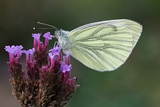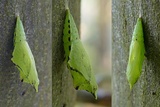Pieris napi (Linnaeus, 1758) Species
Last modified: Jan. 28, 2025, 1:34 p.m.
A common species throughout Belgium.
Details
- Classification
- Family: Pieridae > Subfamily: Pierinae > Tribus: Pierini > Genus: Pieris > Species: Pieris napi
- Vernacular names
- Klein geaderd witje (NL), Green-veined White (EN), Piéride du navet (FR), Rapsweißling (DE)
- First mention in Belgium
- De Sélys-Longchamps E. 1837. Catalogue des Lépidoptères ou Papillons de la Belgique, précédé du tableau des Libellulines de ce pays. — — : 1–29. On page 15 (as Pieris napi). view page
- Status
-
Native
Distribution
Egg
Eggs are pale yellowish when freshly laid, turning pale greenish later. The eggs are laid singly on the underside of the leaves of the larval foodplant.
Caterpillar
The larva resembles the one of Pieris rapae but lacks the yellow dorsal line. The lateral stigmata have yellow spots like in Pieris rapae but these lack in the second and third thoracal segment.
Bionomics
An overview of the bionomics of this species can be found on the Butterflies in the Benelux website.
Flight periods
The adults fly in at least three generations a year almost continuously from mid-April till September.
Observed on
- Host plant (species):
- Cardamine pratensis, Alliaria petiolata, Sisymbrium officinale and Nasturtium officinale
The larva lives on Cardamine, Nasturtium, Lepidium, Lunaria, Hesperia, Arabis etc.
There is overlap in use of foodplants with Anthocharis cardamines but larvae of that species are specialised in eating the seedbuts of the plants and this species eats the leaves so there is no niche overlap.
Habitat
Widespread and common throughout, often in more natural and more damp habitats than Pieris rapae.







